Update: I also have a soy-free corn-free version of my homemade whole grain chicken feed! For easy formulating, download Garden Betty’s Chicken Feed Calculator to manage costs, calculate protein content, and custom mix your feed on the fly.
More than nine years ago, I started mixing my own soy-free, mostly organic, whole grain chicken feed, and it’s still the best feed I could possibly give my hens. (I’ve tried the entire lineup from the feed store.)
The decision to feed a whole grain diet—versus a commercially formulated diet—is a personal one based on what I believe is best for my hens. Luckily, it also turned out to be an economical decision and a benefit to my own diet.
Homemade chicken feed is not as expensive or complicated as you may have thought or been told.
My small flock of hens lays two dozen eggs a week on a DIY diet of whole grains and leafy greens. Their feathers are soft and shiny, their personalities as perky as ever… so I must be doing something right!
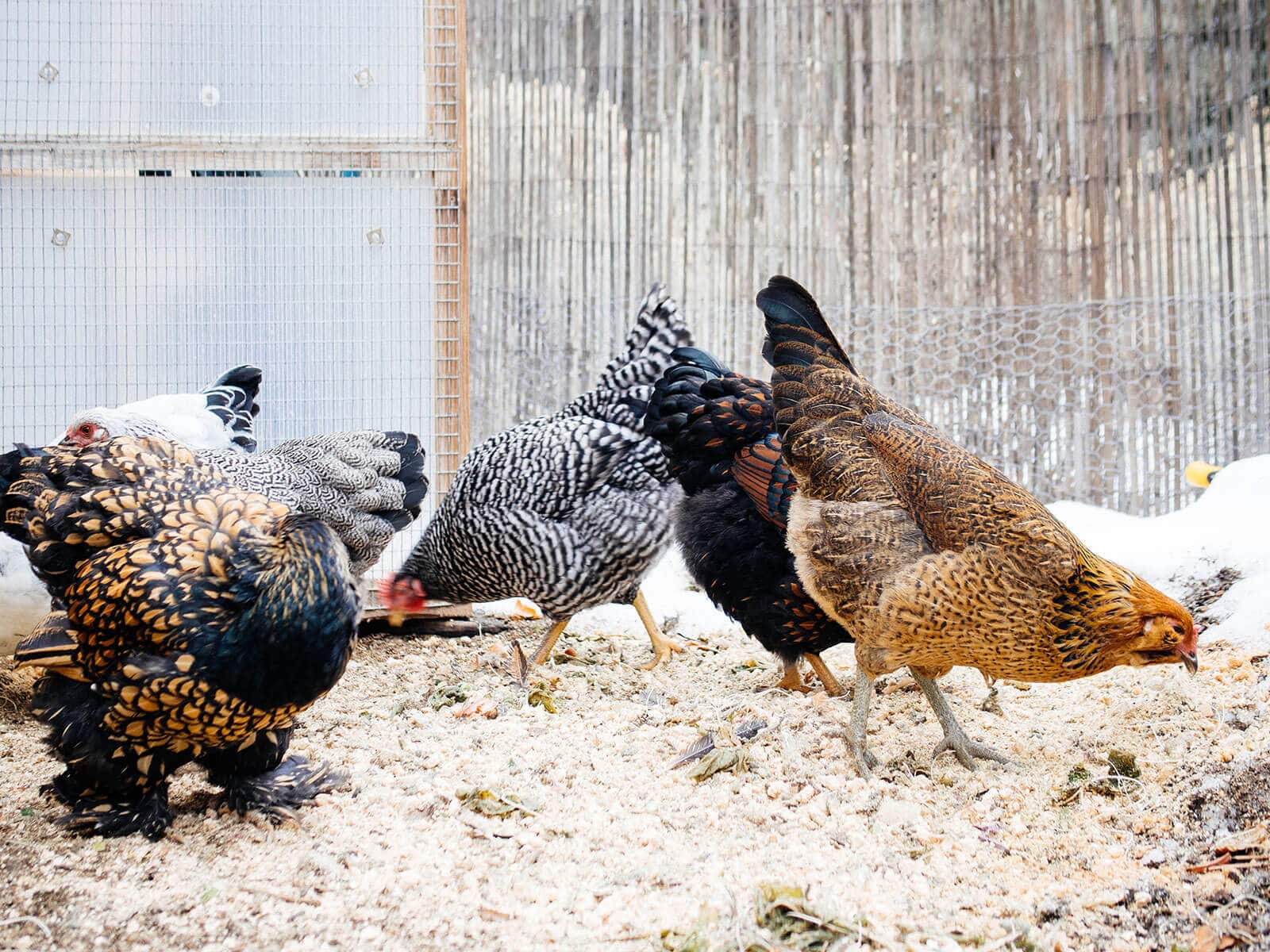
Why should you make your own whole grain chicken feed?
Commercial poultry feed comes in crumble or pellet form, neither of which looks like real food to me. Since real food comes out of my chickens, I want real food to go into them.
Crumbles and pellets are already formulated to contain the nutritional balance that a chicken needs, but the process of cracking, mashing, pressing and/or heating the grains (often times, not even quality grains) causes them to go stale and lose some of their nutritional value—even months before you buy them.
On the other hand, whole grains (which you can pick and choose) retain all of their nutrients.
With a whole grain diet, I’ve noticed that my hens eat less and poop less (as opposed to the crumble diet they started on). This leads me to believe that their bodies are processing the food better and it’s not just passing through them.
Disclosure: Garden Betty earns commissions on purchases made through these links to my affiliated retailers. View my policy.
Is a homemade whole grain diet a complete diet for a chicken?
Like humans, chickens need a diverse diet and sometimes they need a different diet in winter than they do in summer.
The greater variety of grains, legumes, and seeds you can provide your chickens, the healthier and happier they will be.
Layers need at least 16 percent protein and the rest is common sense—not too much fat, not too many carbs, and that last piece of chocolate cake is probably not a good idea. It’s all about balance.
I imagine that people wanting to make their own feed at home are likely also the sort of chicken keepers that let their chickens forage for bugs and weeds, or give their chickens mealworm treats and kitchen scraps. So overall, yes—this is a complete diet.
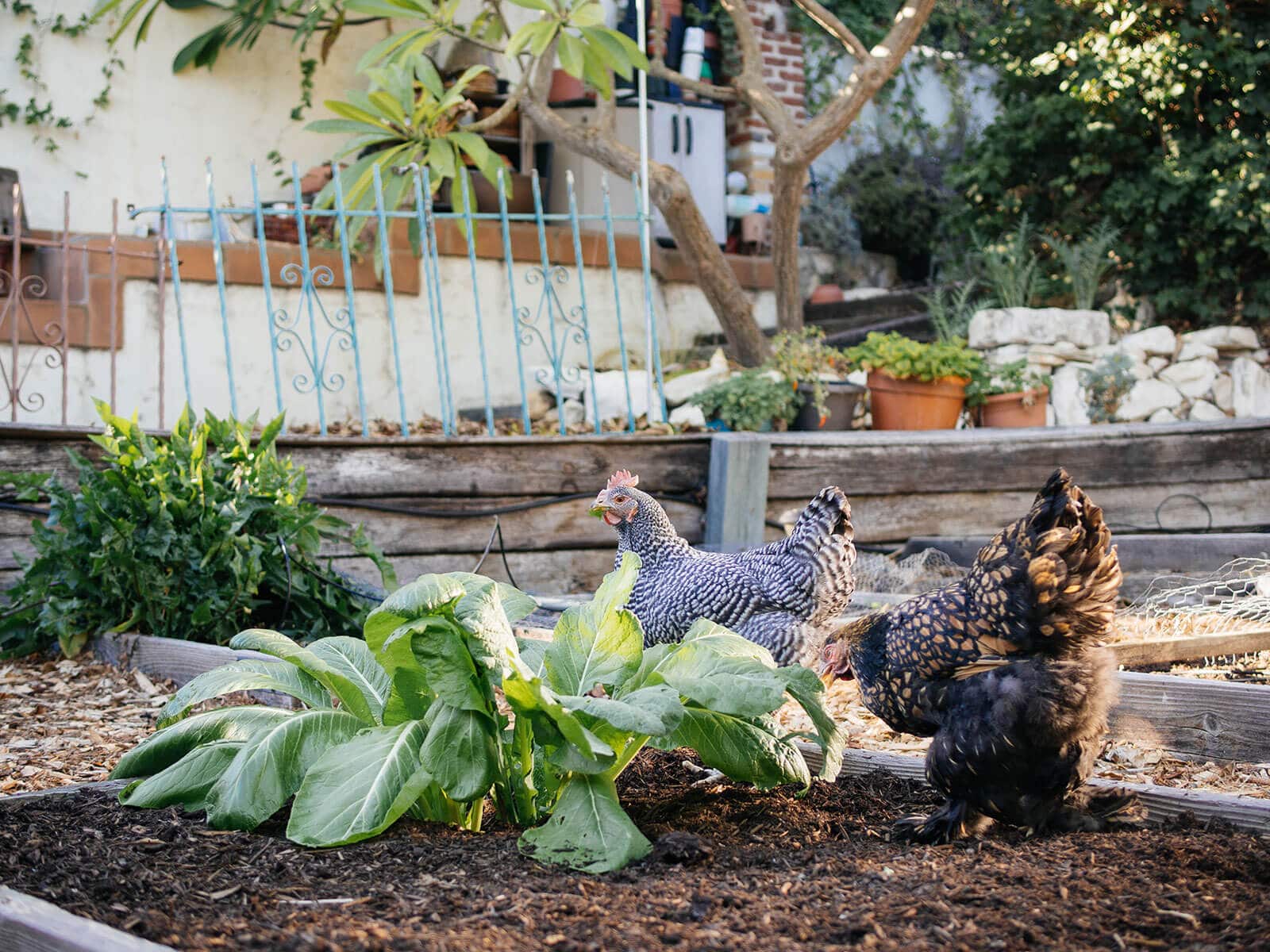
Why should chicken feed be soy-free and organic?
Because of its cheapness, availability, and high amount of protein, soy is a large part of a commercial chicken’s diet. But it’s also an incomplete protein, an unnatural source of food, and a highly processed food.
As with anything highly processed, soy has potentially harmful health effects ranging from vitamin deficiencies to hormone disruptions—especially when consumed in the crazy amounts that our culture does.
Soy is one of the most genetically-modified foods in the world, and it’s included in almost everything we eat. I know I can’t avoid it in my diet, but I can limit my intake of soy by choosing not to feed it to my chickens. You are what you eat.
(A pro-soy study found that soy protein transferred to the egg yolks and tissues of commercial chickens—even commercial “organic” chickens—fed a predominantly soy diet.)
An all-organic feed was originally not as important to me as a soy-free feed. I felt the benefits of a whole grain diet outweighed those of an organic (but processed) diet.
As it turned out, my homemade poultry feed is almost all organic, thanks to bulk purchases from Azure Standard and my local supermarket.

How much does DIY chicken feed cost?
My homemade chicken feed actually costs the same as the commercial poultry feed at my local feed store. This may not be true for everyone, but on the west coast, a premium bag of soy-free, organic layer pellets averages $0.70 per pound.
My soy-free, almost organic, whole grain feed costs $0.69 per pound (and would even be less if I purchased in larger bulk quantities—but I have a small flock and very limited storage).
This isn’t cheap chicken feed by any means, but it’s also not exorbitantly expensive considering the quality ingredients that go into it. You can lower the cost by going in with a fellow chicken-keeper on 50-pound bags of grains, or by using animal-grade ingredients instead of human-grade (which is what you’ll find in feed stores, and they’re perfectly acceptable).
An unexpected advantage of mixing my own feed is that I can share a lot of the grains, legumes, and seeds with my chickens, and I even use some of the same grains in my homemade dog food.
The ingredients are all human grade and mostly organic, and the fact that they can feed the whole household makes buying 10- or 25-pound bags of grains more feasible.
While there was a lot of legwork in the beginning to make my own recipe, the payoff is learning more about nutrition than I ever thought I would and knowing what goes into my chickens’ food (and ultimately, what goes into me).
I mix a new batch of feed two or three times a month. It feels like garden therapy. I have a strange love for running my hands through a mountain of whole grains.
It’s not any more work than refilling the feeder with bagged feed, and I have the option of changing up the mix every once in a while, rather than being stuck with the same 50-pound bag of commercial feed.
(This is advantageous if you have a mixed flock of chicks, pullets, and/or layers with varying protein needs, or want to alter their diet in winter or summer. I cover the nutritional needs of different age groups in my post that helps you calculate protein for your own chicken feed.)
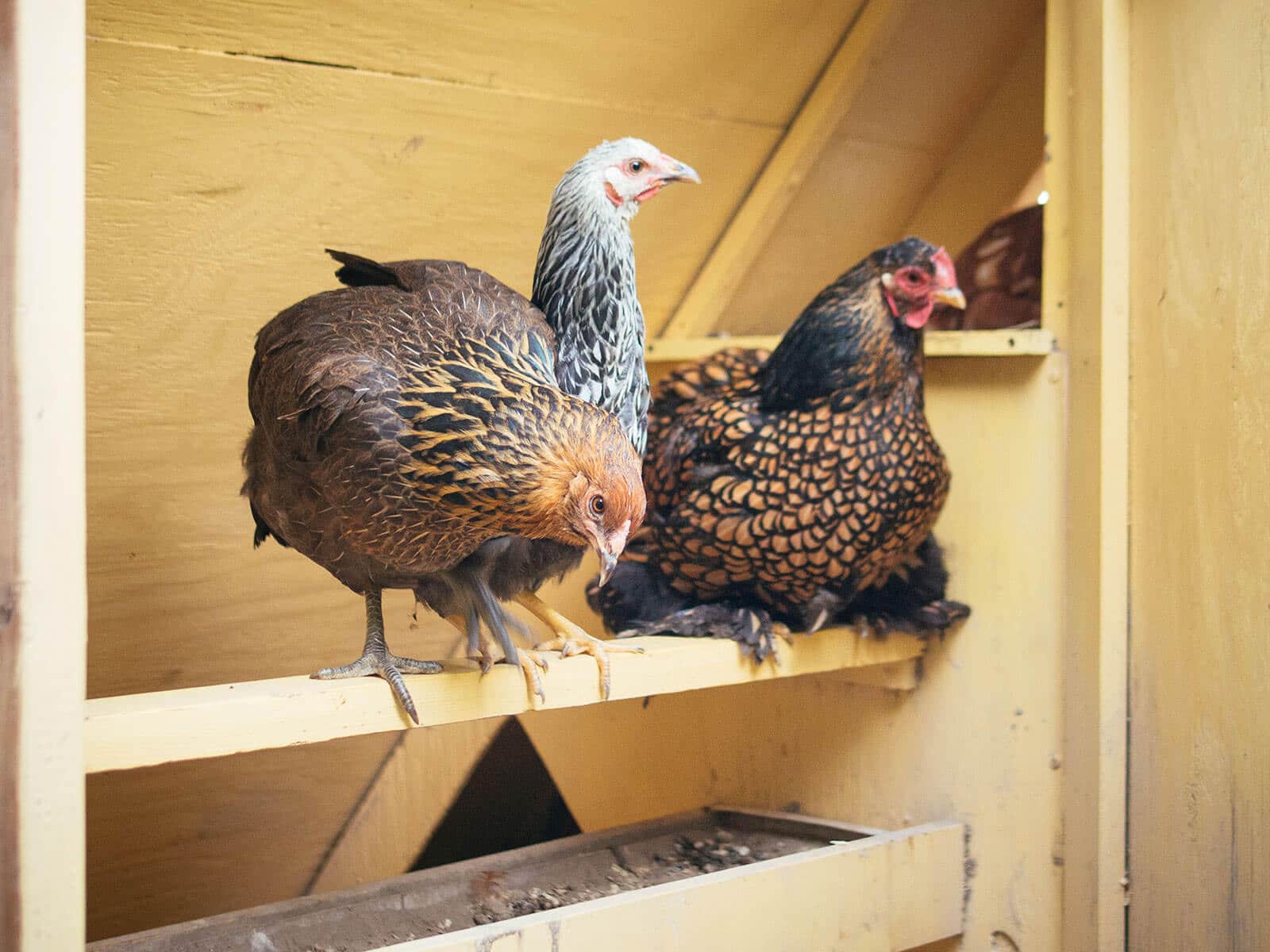
How do you find all the ingredients for homemade chicken feed?
Most of my grains are purchased from Azure Standard. As a natural food co-op that delivers nationwide, Azure Standard carries bulk bags of hard-to-find items like kamut and kelp, and sometimes at a better price than Amazon.
The rest of my ingredients come from local stores with a wide variety of bulk grains. (WinCo Foods was my go-to in Southern California, and still my favorite for cost, selection, and convenience. Market of Choice is my current stop in Central Oregon when I need a last-minute refill or want to try something new.)
You can find more exotic grains at places like Whole Foods Market, Sprouts Farmers Market, and in countless other natural food grocers and bulk food markets.
Your local feed store or grain mill will also carry the basics like oats, wheat, millet, and corn.
Oyster shells and grit are common ingredients found at any feed store or farm/livestock/poultry supplier.
How do you store all the whole grain ingredients?
Whole grains store for a very long time in cool and dark locations. Unless you go through a lot of feed quickly, I wouldn’t suggest keeping the grains in their original bags once opened, because weevils and rodents will think they’ve scored a buffet.
If you have a lot of space or a lot of chickens, you can dump all your ingredients into a clean metal trash can with a lid or a large galvanized steel bucket with a lid, mix them all up, and scoop out from there.
If you lack adequate space or keep a small flock, like I do, you can store the ingredients in airtight bins and mix as you go.
I scoop everything into a flexible bucket, give it a good mix, and pour the fresh food into the feeder. It’s like Christmas Day for the chickens… multiple times a month!
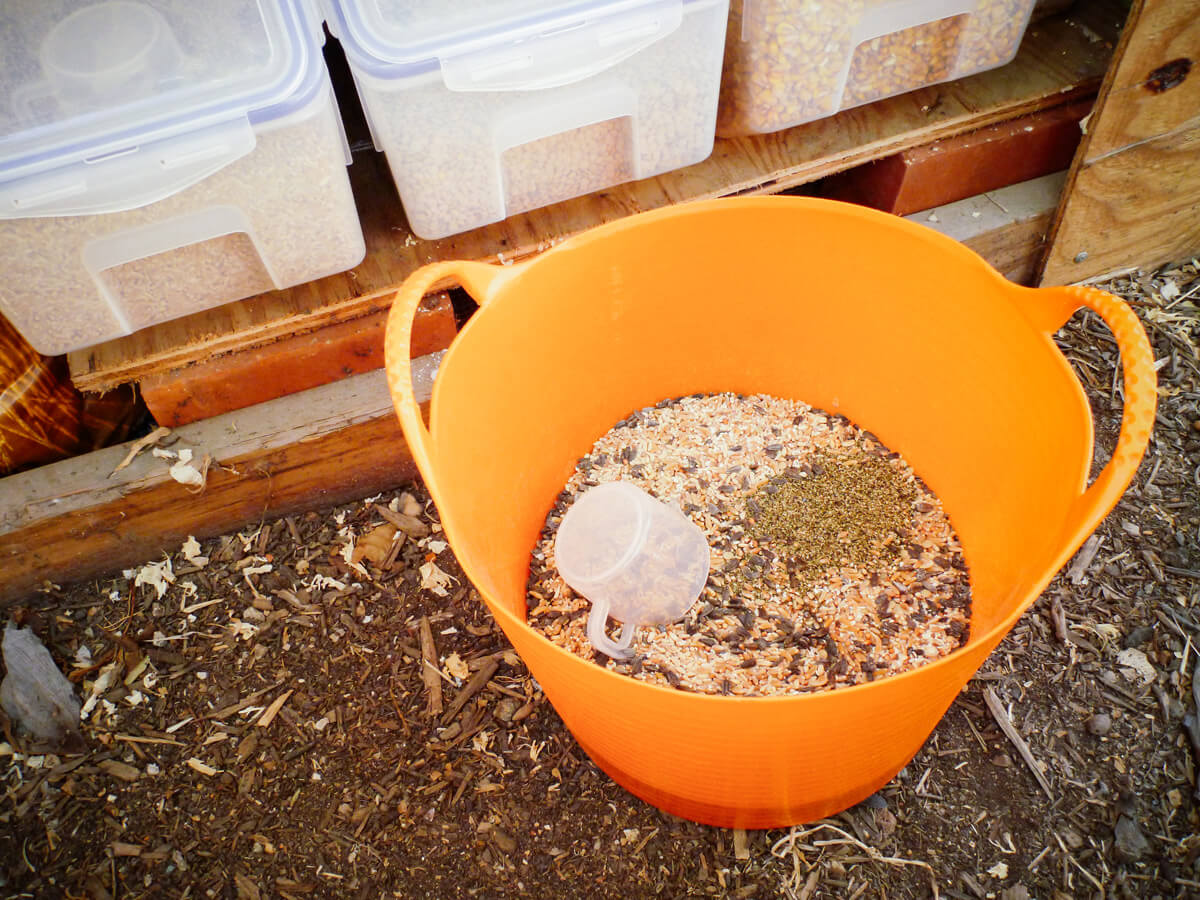
Update: Since this post was originally written, I’ve moved on to a new chicken coop that doesn’t have on-site storage, so I keep all of my grains and seeds in the garage. I’ve also added a few other containers — that I like just as much, if not more than my first containers — which are all linked in my sources at the end of this post.
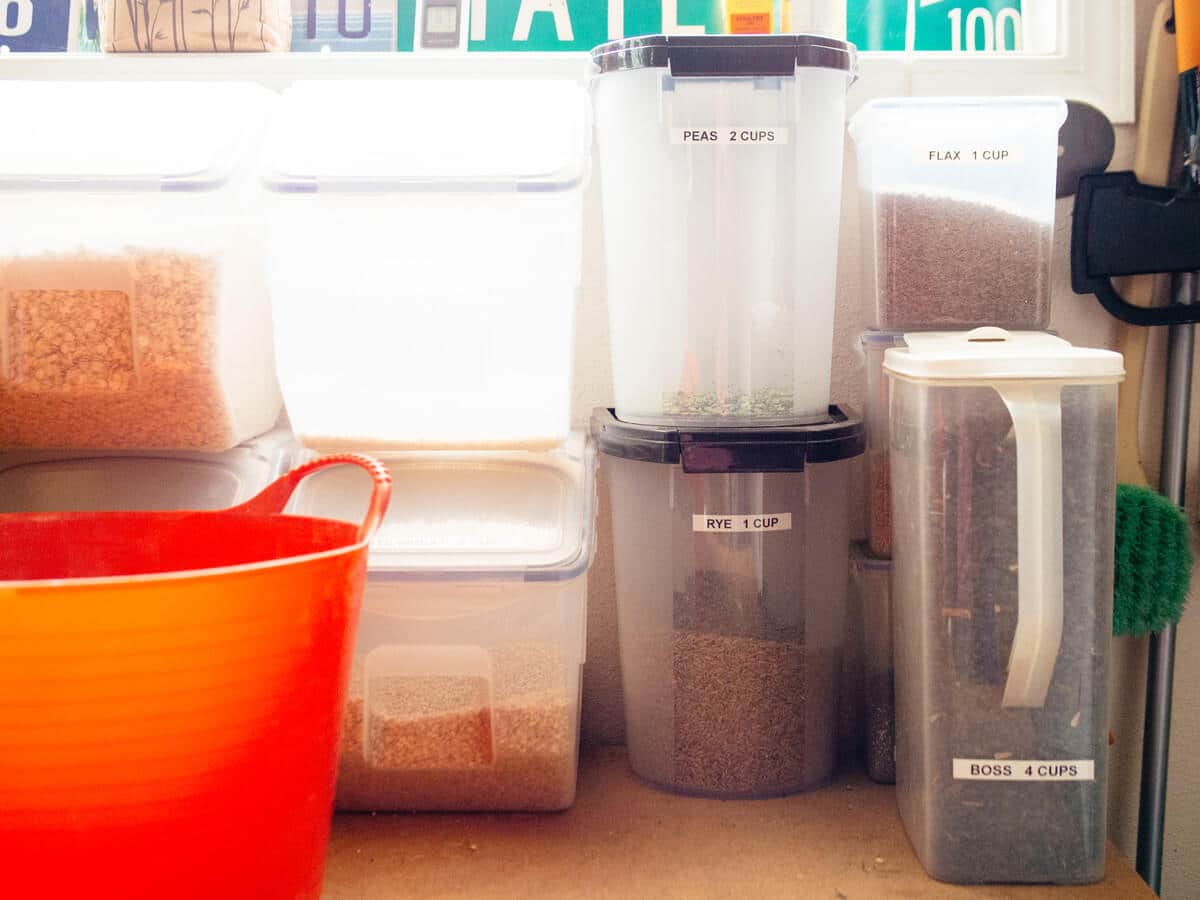
How do you switch a flock from crumbles/pellets to whole grains?
Start by gradually mixing in a little bit of whole grains into your chickens’ current feed to adapt their gizzards.
If they don’t forage frequently, make sure you offer them grit in a separate, free-choice feeder (I use this one).
Chickens don’t have teeth, so they swallow a small amount of grit and store them in their gizzards to grind up food. This is especially important for whole grains that need to be broken down.
Increase the amount of whole grains in their feed each week, until eventually you’re only feeding them whole grains. It may take a few weeks for your chickens to adjust to the change, so don’t be alarmed if egg production drops off a bit.
They may also start flinging grains all over the place (you’ll soon learn what they like and don’t like) or picking out certain grains first. (I believe chickens know what their bodies need nutritionally, so some days they may feed on more protein, less calcium, etc.)
Because of this, it’s a good idea to start with small amounts of different grains and seeds, and see what your chickens will eat before buying in bulk.

How much protein do chickens need?
My homemade chicken feed is around 17 percent protein, which is in the target range for laying hens.
This is a good number to know if you’re only feeding whole grains. But if you supplement their diet with pasture, scratch, mealworms, and kitchen scraps, all that food will increase (or decrease) the amount of protein they take in each day, so don’t get too hung up on the number.
The cool thing about making your own feed is being able to custom make it for your flock. You can make this chicken feed in bulk if you have a larger flock, just scale the recipe accordingly.
Keep reading for lots of suggestions and alternatives so you can create the best homemade chicken feed for your flock!
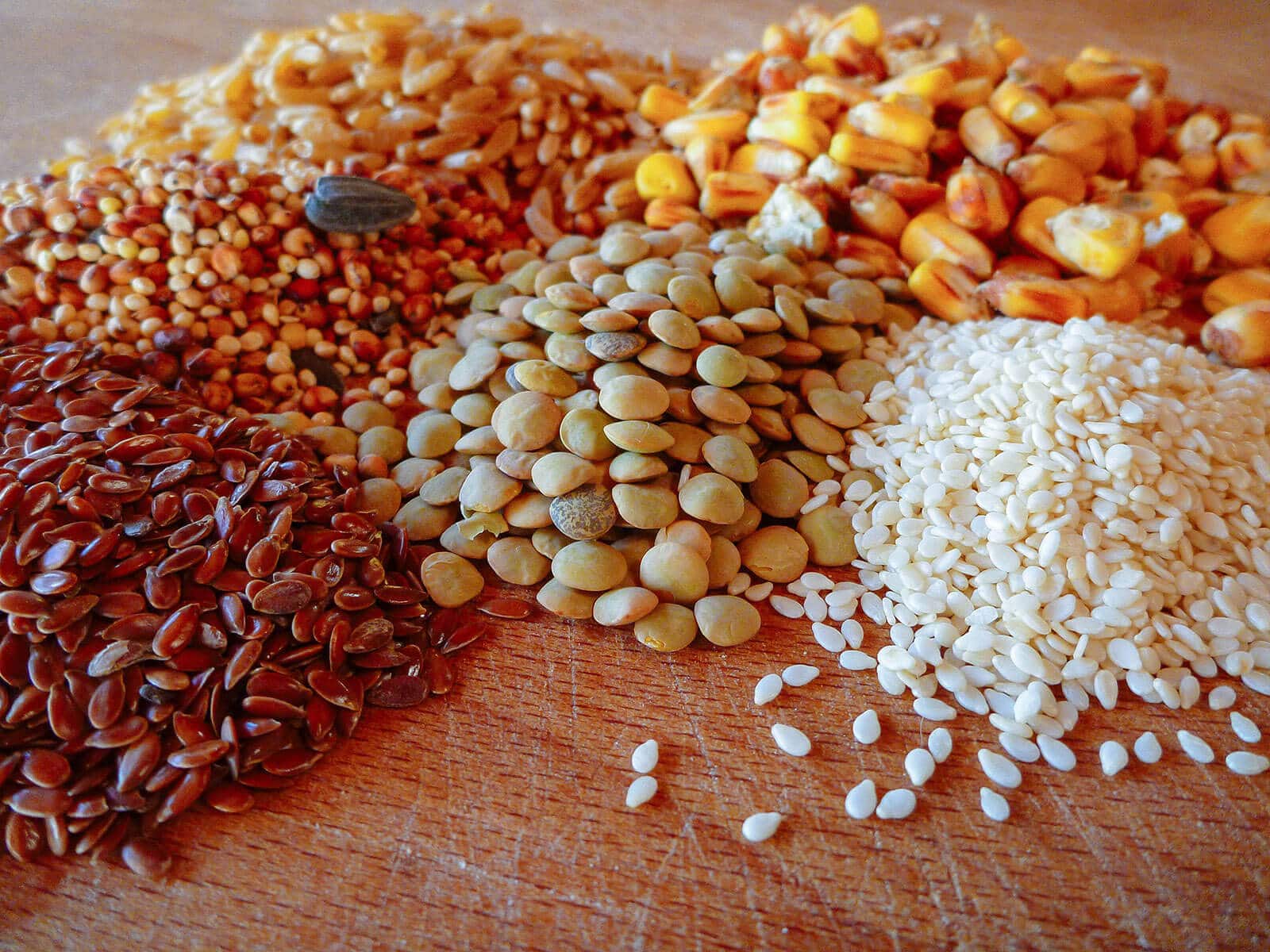
Garden Betty’s Homemade Whole Grain Chicken Feed
Makes 8 1/2 pounds (fills 10-pound feeder)
Ingredients
4 cups oat groats
4 cups black oil sunflower seeds
4 cups hard red wheat berries
2 cups soft white wheat berries
2 cups kamut
2 cups millet
2 cups whole corn
1 cup lentils
1 cup sesame seeds
1 cup flax seeds
1/2 cup brewer’s yeast
1/4 cup kelp granules
Free-choice oyster shells
Free-choice grit
Oats are rich in protein (around 16 percent), B vitamins, calcium and fiber. Oats are also a good (and cheap) source of energy. All oats—no matter how they’re processed—are nutritionally similar, so you can feed oat groats, steel-cut oats, rolled oats, and quick oats interchangeably.
Black oil sunflower seeds (often called BOSS) are like candy to chickens. But good candy! BOSS is high in protein (averaging 17 percent), rich in minerals and vitamins, and the high oil content gives feathers a beautiful gloss. BOSS is typically found in the bird seed aisle at pet and feed stores, and I buy mine from a local farm and garden store. You can also substitute striped sunflower seeds (the seeds that are typically packaged as human snacks), but they tend to be larger than BOSS with thicker shells.
Wheat is a major energy source for chickens. If you can find both varieties, buy hard red wheat and soft white wheat for the best nutritional balance. Otherwise, feed only hard red wheat, as it contains more protein (around 15 percent).
Kamut is actually a brand of khorasan wheat, but these days the grain is simply known as kamut… the way kleenex is synonymous with tissue. It’s an ancient Egyptian grain that’s nutritionally superior to other wheat in terms of protein (18 percent), magnesium, zinc, and vitamin E.
Millet (unhulled) is found in most bird seed, and in fact, the millet I buy is a mix of red and white millet sold at the store as “wild bird food.” It’s less expensive than human-grade hulled millet, but still rich in amino acids and iron. Feed stores sometimes label the unhulled white millet as “proso millet” (not to be confused with spray millet, which is a long and thin seed head).
Whole corn is a fairly large kernel, so depending on your chickens, you may have to crack or grind the corn first. You can also feed popcorn kernels, which are half the size and easier for smaller breeds to pick up. Corn is low in protein, vitamins, and minerals, but it does provide energy and fat (which is especially helpful in winter).
Lentils are very high in protein (at least 26 percent) and if your chickens take to them, it’s worth adding more to your feed. Mine don’t particularly care for lentils or any legumes, for that matter, so I only add a small portion to my feed.
Sesame seeds have one of the highest amounts of protein in a seed (around 25 percent), so they’re especially good for picky chickens that won’t eat legumes. They’re also one of the more expensive ingredients in my feed, so I add them sparingly.
Flax seeds boost omega-3 fatty acids in eggs, and are also rich in protein (37 percent), B vitamins, and minerals.
Brewer’s yeast (animal grade) can be found online or at local feed stores. You can buy human-grade brewer’s yeast too, but you’ll end up paying double (at least). It’s an important source of B vitamins and protein (around 35 percent) for chickens. (On a side note, I’ve also read that feeding brewer’s yeast to your dog will repel ticks and fleas, in addition to providing all the other good stuff.)
Kelp granules (or kelp meal) are basically little bits of dried seaweed. Kelp contains essential vitamins, minerals, amino acids, and salt that your chickens need. It promotes healthy growth, increases egg production, and darkens yolk color—an overall superior supplement.
Oyster shells provide the necessary calcium to strengthen your chickens’ eggshells. Feed this free choice, and they’ll take what they need each day. You can also feed them clean, crushed eggshells to put all that calcium back into their bodies.
Grit is typically limestone or granite gravel that aids the gizzard in grinding food. If your chickens free range, they’ll probably pick up little stones on their own and won’t take as much from the free-choice grit.
Other good sources of protein include triticale, field peas, and split peas (or any peas in general — many soy-free commercial feeds rely on peas to provide sufficient protein).
If money is no object, you could also add quinoa, spelt, wild rice, amaranth seeds, nyjer seeds, hemp seeds, or shelled peanuts as excellent protein sources.
Feeding lower-protein grains like rye, barley, buckwheat, and sorghum (milo) in small amounts will balance the higher-protein (and usually higher-cost) grains.
Try not to make your feed too heavy on any particular grain. The University of Kentucky College of Agriculture offers good information on the pros and cons of common feed grains on their Poultry Extension site.
At the end of the day, if you feed a balanced meal of grains, greens and garden pests—with a little treat here and there—numbers are not as important as a diverse diet.
Where to buy chicken feed supplies
[show_shopthepost_widget id=”3116483″]
Lock & Lock Bulk Storage Bin | Lock & Lock Square Tall Food Storage Container | Buddeez Plastic Storage Container for Pet Food | Iris Nesting Airtight Pet Food Container | Tubtrugs Storage Bucket | Miller Baby Fig Feeder | Little Giant Galvanized Hanging Feeder | AniMed Pure Brewers Yeast | Starwest Botanicals Organic Kelp Granules | Scratch and Peck Feeds Oyster Shell | Scratch and Peck Feeds Grower Grit
Homemade Corn-Free Soy-Free Chicken Feed With Whole Grains
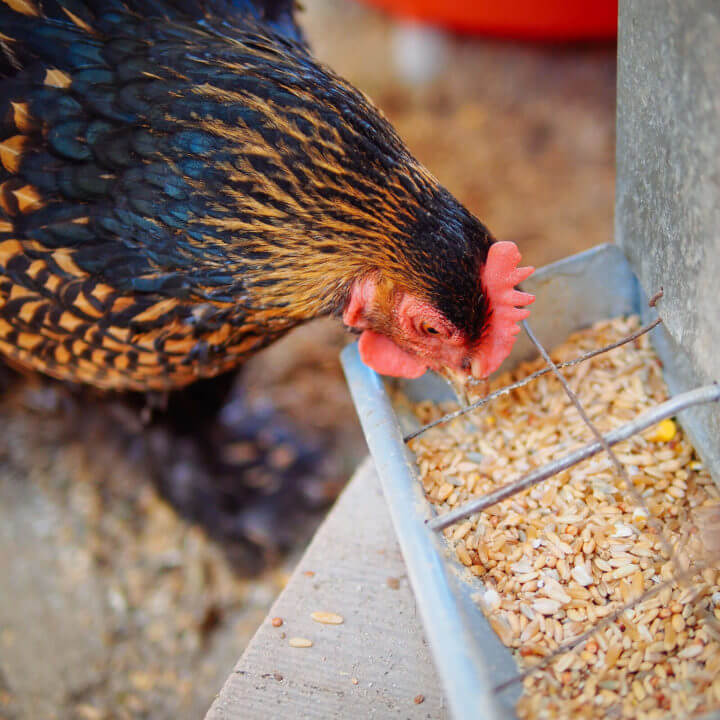
Garden Betty's homemade whole grain chicken feed just got better. This new recipe is corn-free (as well as soy-free) and makes the perfect feed for your favorite layers.
Ingredients
- 4 cups oat groats
- 4 cups black oil sunflower seeds
- 4 cups hard red wheat berries
- 2 cups soft white wheat berries
- 2 cups triticale berries
- 2 cups rye berries
- 2 cups millet
- 2 cups sesame seeds
- 1 cup flax seeds
- 1/2 cup brewer’s yeast
- 1/4 cup kelp granules
- Free-choice oyster shells (or crushed eggshells)
- Free-choice grit
Instructions
- Combine all of the ingredients, except the oyster shells and grit, in a small bucket.
- Fill your feeder with the mixed-grain feed, or store the feed in a pet food container or a galvanized steel bucket with a lid.
- Offer the oyster shells and grit in separate small feeders for your chickens to eat as they wish.
This post updated from an article that originally appeared on June 29, 2012.
View the Web Story on homemade whole-grain chicken feed recipe.


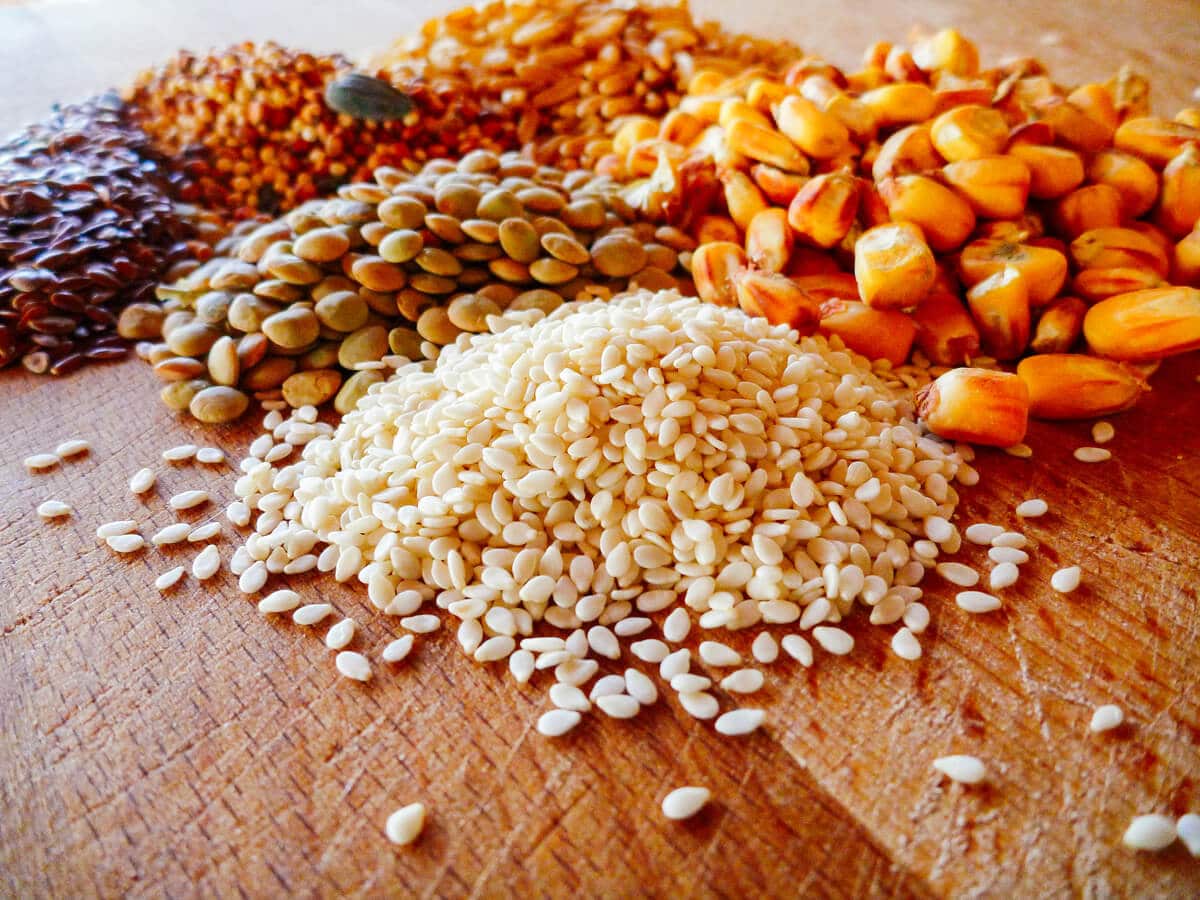

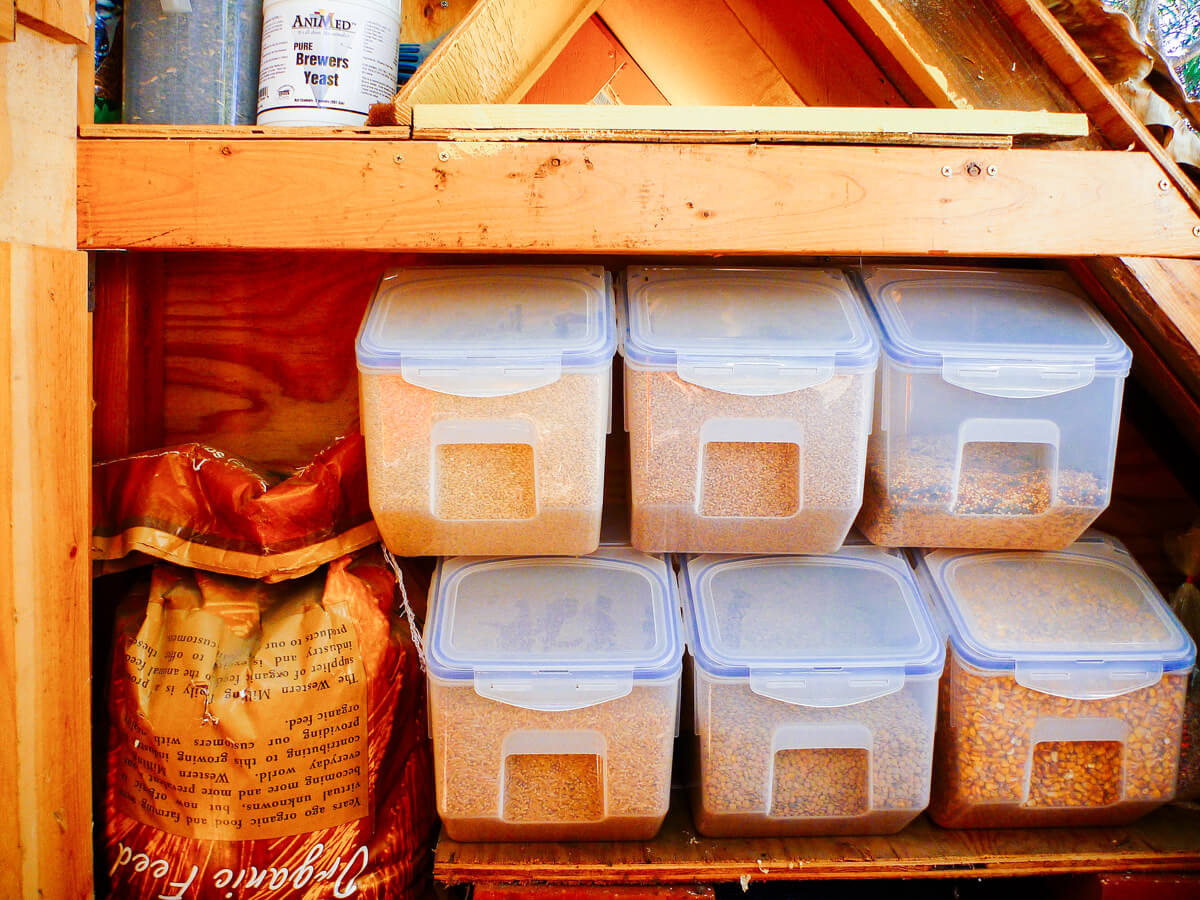
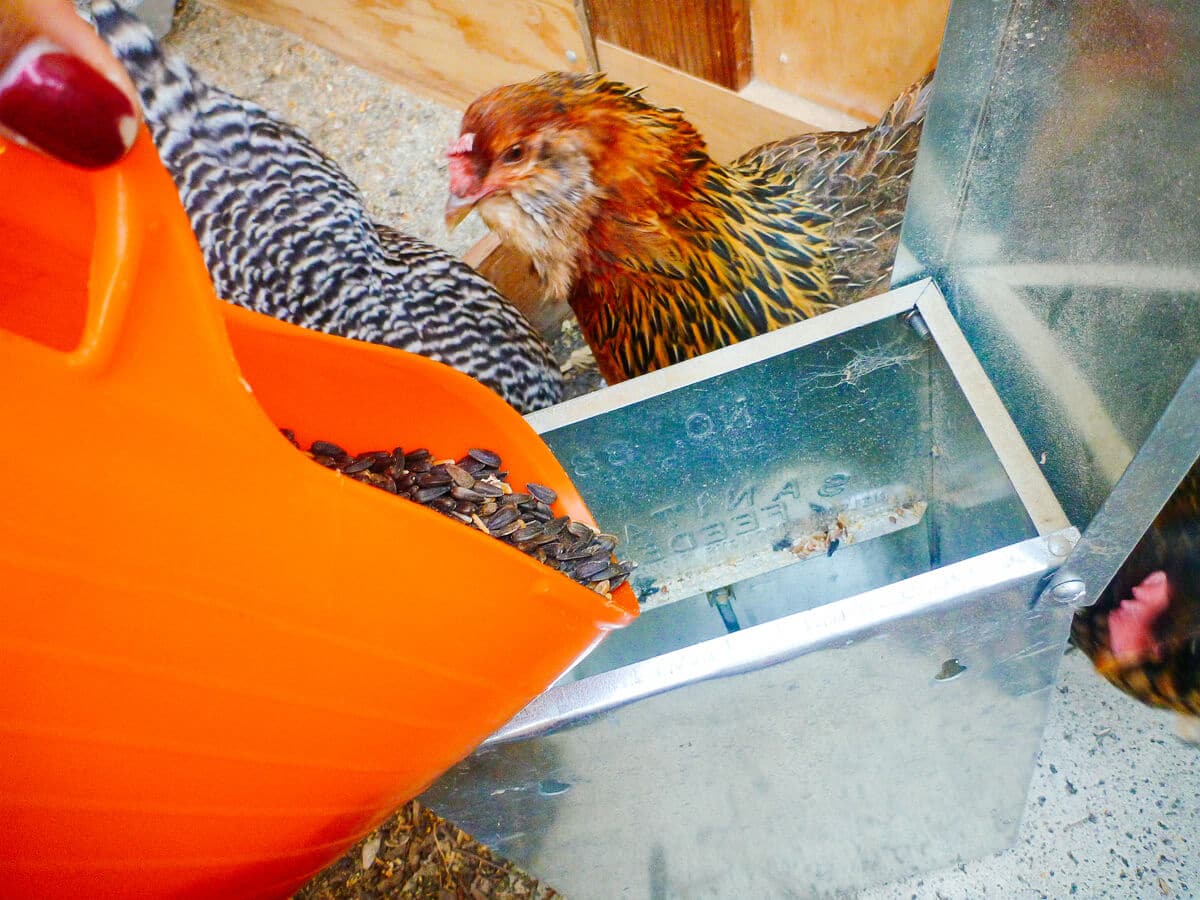













I just found your site. I am so happy I did! Now I want to feed my chickens like this and my dogs! I will be feeding my dogs homemade food soon. The chickens feed will have to wait until I can gather everything I need. My question is…can you specify what you get from azure and which ones you get from winco? I’m willing to do all the work to give my free range girls the best, just want to make sure the cost is as efficient as yours. Thank you!
These days my recipe is slightly different from the one posted, as I vary the feed according to what’s available from Azure or my local store. The ingredients I DON’T buy from Azure are typically brewer’s yeast (I get this in bulk from Amazon or a feed supply store), BOSS and flax (Winco), and millet, oyster shells and grit (feed supply store). I compare costs every few months when I reorder since I can sometimes find a better price locally. It all depends on where you are. I recommend keeping a list of how much each ingredient costs per pound, so that you can always spot a good deal when you come across it.
How did you formulate your recipe? Where did you learn the specific dietetic needs of chickens? Do you know how much of each vitamin and component that chickens need and how much is in your feed? It would be very easy to get way off on certain nutrients if you don’t know the science behind it. Vould you please give me some links to the scientific basis for your feed recipe?
I formulated my recipe by using a spreadsheet that I created at http://gardenbetty.com/2014/11/garden-bettys-chicken-feed-calculator-for-determining-your-protein-content/ (which is also linked in my post above).
As for where I learned about the dietetic needs of chickens, I studied several cooperative extension and poultry science sites run by various universities’ agriculture departments. The best one I have found, which caters specifically to small flocks and puts everything in layman’s terms, is the University of Kentucky’s Poultry Extension, linked above in my post. Their main site, which covers all nutrition (not just grains) is at http://www2.ca.uky.edu/smallflocks/Nutrition.html and within those pages are links to other poultry sites that I’ve followed and gleaned information from.
Do I know how much of each vitamin is in my feed? No, that kind of information would be impossible to determine outside of a lab. I can only calculate the protein value, and even then, my chickens forage and feed on bugs, weeds, and kitchen scraps, so I would never truly know how many vitamins, minerals, and amino acids they’re actually getting each day.
Personally, I choose to provide the necessary nutrients through a homegrown pasture and the dozen-plus grains, seeds, legumes, and supplements listed in my recipe. However in the comment thread here, I’ve recommended that some chicken keepers who aren’t able to source such a wide variety of ingredients to supplement their feed with a vitamin premix, such as Fertrell’s Nutri-Balancer (which Azure Standard now carries). It’s great for filling in the gaps.
I have a corn Q. Is whole corn the same as popcorn kernels? That is all I can find, besides various forms of cornmeal or grits. Can they eat unpopped whole popcorn kernels? is that what you use? thanks 🙂
Whole corn is basically dried yellow corn kernels – different from popcorn kernels. Whole corn is the whole grain version of the cracked corn sold in feed stores (typically in scratch blends). Chickens can eat either type of corn, and I used to add unpopped popcorn kernels to my flock’s feed (they loved it at first, but months later decided they no longer liked any corn… go figure).
I like the idea of whole foods, but I have heard that whole (rather than split) grains is hard for the chickens to digest. Thoughts?
Chickens have gizzards which help break down food. Free-range chickens will actually swallow little stones (grit) and store them in their gizzards (a sort of specialized stomach). The grit acts as teeth and grinds up all the seeds, grains, bugs, and anything else they eat before passing that food back to their true stomach.
So no, whole grains are not hard for them to digest as long as they have access to grit.
Thanks!!
One more question – can you tell I am new to this – but does feeding Oyster Shell reduce the need to
offer Grit? It would appear they serve similar functions with Oyster
shell giving added clacium? Thoughts?
Oyster shells and grit are two completely different ingredients with completely different functions. Both need to be fed free-choice.
Thanks!!
Hi Linda,
I will be using your recipe for my day old chicks coming in about a week. I read your answer to a comment earlier in the thread saying to add 20% more protein to the recipe. Which protein should be added and how much? It may seem like a stupid question but I cannot figure it out and my chicks will be depending on this recipe for nutrition so i figured I would just ask, lol. Thanks!
Hi Susie, it’s not 20% MORE protein added to the recipe; rather you increase the recipe to reach 20% protein (the one I posted is around 17%, so you would only be adding around 3-5% more).
I have a calculator that helps you figure out how much of each ingredient to add/change to reach your target protein level. Use my recipe as a starting point, and make changes based on what you have available: http://gardenbetty.com/2014/11/garden-bettys-chicken-feed-calculator-for-determining-your-protein-content/ (and don’t forget to offer chick grit in a separate feeder!)
Good luck!
Great info, thanks so much for posting this.
I’ve read that comfrey is a great sub for kelp. Our chickens LOVE comfrey and pick our plants clean if they get the chance! LOL 🙂
Comfrey is a highly nutritious plant (and makes a great garden fertilizer as well) but I’m uncertain if it’s a complete replacement for kelp. As far as I know, there is no substitute for seaweed in terms of the minerals it provides. But as long as you feed a wide range of grains and seeds, and allow foraging time, your hens should be very happy!
This is such great info! Thanks 🙂 I cannot source tri berries or kamut. Any suggestions for a good sub? Can I sub alfalfa pellets for kelp, and if so, do I need to add salt ?
I get triticale, kamut, and kelp from Azure Standard. Alfalfa is not a substitute for kelp. I use kelp in this recipe to provide some salt and trace minerals not found in the other ingredients.
would this recipe work for ducks?
Unfortunately I’m not familiar with the nutritional needs of ducks.
Is there some type of calculator you used to make sure all your ingredients provided the correct levels of nutrients? I am interested so that I could take your recipe and change it up based on our chickens preferences without messing up the nutrients that the chickens require.
You have to know the weights and protein amounts of each of your ingredients. I put it all into an Excel spreadsheet, which changes each time I buy a new ingredient (my recipe changes slightly every few months based on what’s available from the suppliers).
I have been feeding my pet rooster, Buddy, whole grains for quite awhile and recently I notice that he has developed a preference for millet over wheat (red winter wheat berries used to be his favorite). He also favors flax. He seems healthy and happy, but I’m worried about this change. He also seems to shedding feathers (I think it is a normal seasonal thing). Any ideas on why he would go off wheat or form a preference for milliet? He also gets fresh wheat grass and sunflower sprouts, a small green salad, tomatoes, shredded carrot, etc. He is a most pampered rooster.
Changing appetites and taste buds are normal for chickens, and can be caused by a shift in the seasons or simply new nutritional needs. I’ve found that my own chickens adjust their diet depending on whether they’re laying, molting, hot, cold, etc. Sometimes they’ll want more or less calcium or protein, sometimes they’ll get all they need from foraging around the yard. It’s nothing to worry about unless you notice serious changes in their appearance or their poop.
Love this! Will definitely give your recipe a try. My dogs are on a natural home-based diet so why not my chickens!
I order most of these grains in bulk, and end up sharing them with my chickens and my dogs! (We all have homemade diets.)
Hello, Love your site by the way. I would like to make my own chick crumble. Do I just whizz the mix in the blender for the chicks? Or does it need to be a different mix? Also I live in Australia so I’ll have to substitute some of the grains. thanks for the recipe.
Yes, you can crumble everything in a blender but most of the grains and seeds are small enough for chicks to eat (as long as you provide them with chick grit). Chicks do need more protein though (around 20%) so you should adjust the feed accordingly by adding more of the high-protein grains.
I’d like to start fermenting whole-grain feeds, but I am curious about this mix – will I be able to ferment with this, or will the mucilaginous properties of the flax just make it into one big, jelly-like mass?
I ferment my whole-grain feed (see http://gardenbetty.com/2013/05/why-and-how-to-ferment-your-chicken-feed/ ) and have never had it turn all jelly-like. The grains and seeds (including the flax) more or less retain their shape even when they’re wet. That said, we’ve had a particularly warm year this year, so I’ve been using up my fermented feed every couple of weeks before starting a new batch with fresh grains and fresh water. (At the moment, the fermentation only takes one day in my kitchen.)
Although I LOVE the idea of feeding my 3 chickens this way, after doing the cost research, there is NO WAY the cost is similar to commercial. I can buy a 50 lb bag of quality crumble for $13-16 dollars. The cost of 50 lbs of this mix would be more like %50-60 dollars. (even using the link you provided) 🙁
I may incorporate a few things into their current crumble but I most definitely can’t afford to go “all the way.”
The cost definitely depends on the area where you live and what resources you have available. Here in California (especially Southern California), quality organic feed is much more expensive.
Jodie, where are you located? I am in Northern CA and a bag of Organic Soy Free pelleted chicken feed from a local supplier is roughly $0.85/lb (about $35 for 40#). With what I order from Azure and can get in bulk from the feed store, I am at about $0.60/lb (ends up costing, if bagged, about $25/40#).I am also purchasing larger amounts (25# and up) based on the number of creatures I feed with these grains. Doing a lot of cost research before starting this diet, if I were buying any less quantity, it would not be cost effective. HTH!
Also, I purchase the brewers yeast off amazon – it’s by Thomas labs and it’s a BY + Garlic that is SUUUUPER beneficial to your chickens (and dogs too), even if that’s all you feed in addition to your commercial food.
Hello,
My name is Jess and I have two beautiful, young, sassy-pants hens who I just adore. I used your recipe to make them their first taste of whole grain food. They loved it. I will continue making it for them. Thank you for taking the time to share this recipe with your fans and their own sassy-pants hens.
You’re welcome, and I’m so glad this recipe worked out for your girls!
Hi, Love your site. I’m just starting this whole process and am slowly learning. I have three as well (my kids call them pets with egg benefits!). They hatched May 13, making them three months (12 weeks) today. When can I start this feed? It sounds wonderful!
You can start feeding them whole grains now, but their protein requirements as pullets are slightly different (they would need a little more until they start laying).
this is a great post! my hens have me well trained, i cook a mix of their grains, that has been soaking all day, in a ricepot! never a speck left!
(unlike chicken feed)
Such spoiled little ladies they are!
Hi, do you soak or cook the lentils or do they eat them raw? I’m reading on a lot of other websites that chickens shouldn’t eat them raw :-/
You do not need to cook lentils prior to feeding them to your chickens. They process dry/raw lentils perfectly fine.
Thank you for the receipe, i ll try it because we like our chickens, we have 8 at the moment.
Your flock will love it!
Do you know if Kelp powder would work just as well?
Yes!
Where is the best place to obtain the products used in the feed mix?
I buy most of them from http://www.azurestandard.com. There’s more information in my post.
There’s nothing wrong with feeding chickens non-GMO soy. Saying that it’s not a complete protein as a reason to not put it in their feed is ridiculous, because no other individual item that you’re feeding them is a complete protein on its own, either. Clearly you feel that there’s a stigma associated with soy, but it’s no worse than corn.
Hi, I don’t claim that any of the grains or seeds in my feed recipe is a complete protein. I believe the best protein comes from meat, and a chicken’s diet should include a variety of protein sources; most soy-based feeds rely on only soy for protein. It’s also very difficult to find non-GM soy in the form of feed; you would need to buy human-grade soybeans and cook the toxicity out of them. But in my opinion, processed soy (even non-GM) pales in comparison to animal protein, which is widely available, and often free if foraging is an option.
By the way, I also offer a corn-free (and soy-free) feed recipe here: http://gardenbetty.com/2013/04/homemade-whole-grain-chicken-feed-updated-and-now-corn-free/
Soy messes with the endocrine system and is not good for humans to consume (which you get through the eggs).
I am having an impossible experience finding kelp granules! Can you help me locate? Thank you
I buy kelp granules in bulk from Azure Standard ( http://www.azurestandard.com). It’s the best price I’ve found online, and a bag lasts forever.
well, I have bought alot from them in the last two months!! Cannot believe I missed that! So irritated at myself…I guess at the June drop I will have some. Thank you Linda..
Linda, Thank you so much for your informative blog! I have just made my first batch of your non-soy recipe and have reduced my costs from $1.48/Lb. (from Scratch and Peck – wonderful and awesome – but expensive if paying $17 for shipping) to $1.09/Lb.!
I also enjoy your level-headed and informed responses to comments.
Thank you, thank you, thank you!!
You’re welcome, and thank you for reading!
Will be getting my first chickens soon. They will be a couple days old? How do I go about making a feed for them? …… so glad I stumbled on your site!
Hi Celina, if you read through all the comments on this thread, there are lots of great ideas and suggestions for adapting this recipe to chicks. (You may have to scroll all the way down, but the information is all there!)
Can’t wait to get started. Do you ever grind the grains for the chickens? At what age do you start feeding it to them? Thanks!
No, I never grind the grains. Chickens have a built-in grinder called a gizzard that pulverizes all the food they store in their crop throughout the day. If you start feeding them whole grains early, you actually help them develop a stronger gizzard (just be sure they have access to grit or stones, as they will sometimes eat them to aid in the grinding).
Just realizing that you had posted quite a while ago on this. Is it too late to start now in November when my chicks were born last winter/spring?
You can start your flock on a whole grain feed any time.
This is really helpful!! Thank you! I’m a new chicken mom and have been looking for a great recipe to make myself and this is perfect!
You’re welcome, and good luck! Your chickens will surely enjoy it!
Linda,
Just wanted to say that you have some very good information here, those who feel otherwise are free to their opinion, but as a full time farmer who raises and sells, among other things, free range poultry I say you are right on. We grow our own grains on 150 AC of rotational crop land, and our layers, broilers, and turkeys all eat whole seed diets in addition to all the forage and bugs they can consume. We very much try to duplicate what mother nature does, and birds eat seed and small grains, actually they are the only animals who are truly designed to eat grains. Yes, it will take longer to raise a broiler to market size when feeding a whole seed diet that is soy free, but the results in meat and eggs speak for themselves. Keep up the good work!
Thank you! And your free-range poultry farm should be an inspiration to others.
Linda, I read your other blog and just a suggestion, you can also use Milo in place of corn. There is not a GMO variety I am aware of so for now it is pretty safe, many of the grain varieties have been selectively bred to be higher in tannins as bird losses were pretty high, so clearly they like it. If you can find a sorghum or sweet sorghum variety, also called “cane” in some areas but not the same as the real sugar cane, we grow Dale, they tend to be more appealing to birds as most are quite old genetics. We harvest some of our crop to press and boil for molasses an the rest we allow to go to grain for our feed.
Milo is a great idea! And one I’ve seen my bulk supplier carry too.
I’m a newbie to raising chickens – I just received my four girls from a hatchery a few days ago. I purchased them as “started pullets” ages 15-22 weeks old. I’ve followed your recipe for corn-free feed, and have been keeping available to my four girls free choice. Is this recipe adequate given their ages, or should I be using a grower feed instead?
My feed recipes are appropriate for layers. For pullets, you should increase their protein a bit with extra helpings of high-protein grains (check the other comments in this thread for ideas). Free-ranging is wonderful for them, as they can also get more protein from the bugs in the ground. They also don’t need the oyster shells right now since they’re not laying, but they’re probably not eating them anyway. I’ve found that my chickens are quite intuitive when it comes to their own nutritional needs, as they won’t touch the oyster shells while they’re molting (and have stopped laying).
Will do on the extra protein, thanks. And, I’m waiting until they start laying to put out oyster shell. Thank you! 🙂
Legumes need to be, must be, roasted/cooked before being fed to poultry. Chickens do not like uncooked or roasted split peas or lentils because they are not good for them; this is common feed making knowledge.
This is true of beans (some of which are toxic to humans when uncooked as well), but I have yet to find any studies showing that uncooked peas or lentils are not good for chickens. If you can clarify what being “not good for chickens” means and have a link to your source, I’d like to read more about it. Also, many commercial mills and feed makers who sell soy-free feeds use uncooked peas as their primary protein source (Modesto Milling and Scratch and Peck are two that immediately come to mind).
Why do you say soy is “unnatural”? It is no less natural than lentils or peas. Also, you mention soy is an “incomplete protein, an unnatural source of food, and a highly processed food”. Aren’t most plant proteins incomplete? And how is soy highly processed more than any other legume? Also, while you’re right that conventional soy is in our food supply is mostly GMO Soy, this is not the case with organically grown soy. The no soy argument does not seem founded based on what you’ve mentioned here. It is, or course, your choice to feed your poultry whatever it is you feel good about. I just don’t understand the “anti-soy” sentiment. The same way I don’t understand the way some folks are set on feeding their chickens a vegan diet. Chickens eat bugs, worms, mice, snakes, etc, they don’t want to be vegan…
When I say soy, I’m referring to processed soy and not soybean in its natural state. When I say incomplete protein, I’m referring to the people who rely heavily on soy for protein, whether for themselves or their chickens. Yes, organic soy does exist, but it’s not easily sourced when it comes to chicken feed. There are many more options when it comes to protein-rich grains and legumes, and this post serves to educate the chicken-keepers who are interested. If you have no problem feeding your chickens soy, then this recipe does not apply to you as you can find a commercial mix anywhere.
As for people who want to feed their chickens a vegetarian diet, I blame factory-farm eggs that blatantly advertise “vegetarian fed” labels on their cartons as if that’s the norm.
Excellent point Old Orchard Homestead. I wondered myself where the organic fish meal or other protein source was. Also she buys wild bird seed and there have been several lawsuits over the high pesticides, chemicals, and molds in wild bird seeds killing wild birds. I like the general over all idea and appreciate the seed information, but the seeds need to be organic.
I do not feed my chickens organic fish meal. They get plenty of protein from foraging in the yard for (organic, I suppose) insects and this feed contains the proper amount of protein for my laying hens. You are free to supplement your hens’ diet with organic fish meal, but I don’t know, how much mercury does organic fish meal contain? Should that be of any concern?
Also, it is unfair to generalize about all wild bird seed being tainted with pesticides. While this was true of Scott’s (Miracle-Gro) bird seed and others I may not be aware of, there are many others considered “natural” even if they’re not certified organic. I don’t specify brands in this post, as I trust the readers who are interested in making their own feed will go with their instincts and with what’s available to them.
I grind my seeds and grains and use warm water to make a gruel in the wintertime. It keeps them from picking out what they don’t like. They eat like pigs.
If I’m sensitive to wheat, should I stay away from feeding my chickens wheat products? I was wondering if that would then cause me to be sensitive to the eggs.
All chickens are fed wheat products, so if you’ve been fine eating store-bought eggs, you’ll likely be fine eating backyard eggs.
All chickens are NOT feed wheat products. Wheat is expensive, and the commercial industry avoids it at all costs. Store bought conventional eggs are usually primarily corn and soy. I’m sorry Garden Betty, but I’ve found too many blatantly incorrect statements on this page alone.
It’s true that the cheapest eggs at the supermarket are based on corn and soy. But if you strive to buy “better” eggs, wheat is a major ingredient in the feed as it’s still very cost-effective.
As for my posting of incorrect statements on this page, I have to disagree as your views on processed soy are highly debatable and a matter of personal preference.
http://t.co/fbkRzWyVc1 I am looking at some homemade… http://t.co/woe7ZYwFzk
Hi Linda–thanks for this recipe! I have created a new Azure Standard drop here in Southwestern Colorado in order to get the grains in bulk–I have learned a lot from you!! I have been feeding your recipe to my 29 laying hens for the past 2 weeks, and have noticed that they are not eating the small seeds/grains (millet, flax, sesame and lentils are left) nor the brewer’s yeast or kelp. They do not like the split peas, but multiple girls like whole peas–interesting. The yeast and kelp ends up on the bottom of the feeder and they don’t seem to be interested in it. I worry they are not getting the vitamins/minerals they need. Do you think I should stop the small grains and seeds or keep offering them in hopes that they will start eating them? Any suggestions on the yeast and kelp? Thanks for your help!
It does take a while to get a flock adjusted to a new feed, so I’d continue with the small grains but not add new grains until they’d eaten the old grains – if they’re hungry enough, they’ll eat them. If after a couple more weeks you see that they’re really adverse to the small grains, then you’ll need to experiment with other ones.
As for the yeast and kelp, you can try turning your grains into a wet mash – that is, mixing them with a little water – so the powder doesn’t just fall to the bottom of the feeder. A fresh batch of wet mash should be made daily though; leftover mash could turn moldy after a few days.
Linda, you need to help me with a plan to feed out broilers! I do a bunch every year and am sick of the commercial feed with all the gmo’s
I don’t raise chickens for meat so unfortunately I’m not familiar with broiler feed. I know that broilers typically need 20-25% protein, but some farmers vary the feed from start to finish while others give the same feed throughout the broiler’s life. Use my recipe and protein info as a guide to help you formulate, and good luck!
I have been researching several options, will definitely use your recipe. Meal worms are another part of the plan!
I made some chick feed for our babies I’m picking up today. I’m so glad for the comments on this thread! One question – how do you crack the grains at home? My food processor doesn’t seem to be doing a very good job and I’m worried about breaking it! Thanks
I’ve cracked whole corn and whole spices in my coffee grinder before, and that worked well.
Hi Linda i have access to canary seed and was wondering if this is okay to feed my chickens, also i think it is 16% protein do you know differently? Thankyou
Canary seed is just normal bird seed so yes, it’s fine to feed your chickens. I don’t know what the protein amount is, though.
To further on my comment, hemp have absolutely no phytic acid. Hemp seed is packed full of protien and oils which will be very good for your chickens. Please try that out.
Hi, this is all good for your chickens if you want to achieve an “organic look” to your feed, but you are forgetting a very important element of seeds which I am sure you havent realised and you might be making your chickens very malnourished.
Phytic acid.
Phytic acid is found in the hulls of seeds, nuts, whole grains and legumes. It is an inhibitor for the body to absorb vital minerals. Please look it up, and before thinking that unprocessed, dried seeds are good for your chickens, when they are not. The reason most chicken feed comes in pellets is because the food suppliers have prepared the grains and seeds in a way that is most nutritionally viable for your chicken’s consumption (ie, soaking the grains before using to remove a bit of phytic acid)
There is a way around this by soaking all of your grains and seeds first for 24 hours and then drying them again, which should remove about 33%.
But before you continue what you are doing, please look into this. It is an important part of grains and seeds which we are not informed about and could severely cause nutritional damage.
I’m actually very well aware of phytic acid and have read a fair number of reports on its role in digestion. I’m not completely convinced it’s the “bad guy” here because cooking decreases the phytic acid, which is how most people use their grains anyway.
For every study I’ve read that cites the indigestion problems with phytic acid, I’ve read another that touts its benefits as an antioxidant. So, I feel this issue is largely debatable. I’ve yet to find a study that compares a chickens’ digestive system with our own, but seeing as they have a much more intense (lower pH) stomach acid than we do, and they also have gizzards to pulverize all their food, I wonder what kind of effect this has on the phytic acid.
Birds in the wild eat all sorts of grains and seeds with no ill effects, and they supplement that diet with fruits, bugs, etc. As stated in my post above, the chicken-keepers who decide to mix their own feed are also the type who supplement their chickens’ diet with greens and kitchen scraps, or let their chickens roam on pasture… so homemade diets tend to be pretty well balanced.
Commercial pellets are highly processed; the act of heating and pressing low-quality grains into pellets causes them to oxidize and lose nutritional value, so I’d rather my chickens eat fresh, whole grains that they grind up themselves in their gizzards.
If you’re worried that your chickens aren’t getting enough nutrition out of the whole grains you’re feeding them, you may want to look into fermenting their feed, which I explain in detail here: http://gardenbetty.com/2013/05/why-and-how-to-ferment-your-chicken-feed/